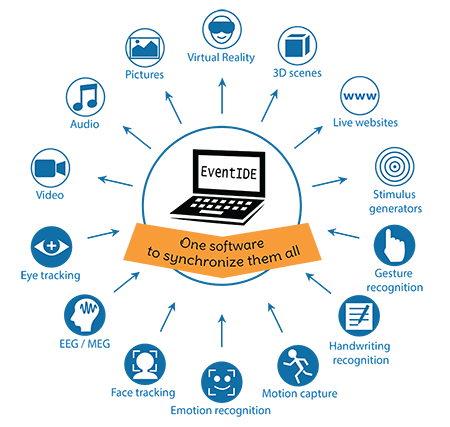
EventIDE
is a visual programming platform for designing and running psychological
experiments. The platform is the most feature-rich and combines a friendly visual designer with professional programming tools. You can check the complete feature list of EventIDE
here and also watch live demos of some features on
our youtube channel Main features ¶
EventIDE belongs to the so-called stimulus presentation software tools. When compared to its competitors, EventIDE excels greatly in complete visualization of design process, experiment scenario and flow logic. Creating an experiment in EventIDE is somewhat similar to creating a slide presentation, except that a user has much more control on flow logic, interaction with hardware and, importantly, runtime adjustments of the designed content.
The core feature of EventIDE is a
revolutionary easy programming paradigm. The paradigm allows virtually any programming language can be used for scripting in experiments. There are no dedicated routines and libraries related to the experiment design and, correspondingly, no necessity to learn them. Writing code is required only for the customization of the experiment logic, which usually takes just a few lines. For example, implementation of the classic Stroop task requires only 14 lines of code in EventIDE. Yet, when it is needed, the power of professional programming languages is fully available in EventIDE.
The modular architecture of EventIDE allows easy integration of user extensions directly to the program core.
System Background
EventIDE is built over the Microsoft .NET - a modern software framework developed by Microsoft that runs primarily on Microsoft Windows. Presently, .NET is the most popular framework for desktop application development on Windows platforms. The .NET framework provides such modern features as interoperability, Common Language Runtime engine, language independence, common Type System, simplified deployment, security and portability. All these feature not only engaged in the EventIDE application itself, but also available for users who code experiments in EventIDE.
Modular Application Architecture
EventIDE has a modular architecture with a basement on the immutable core (~20% of the present application). The rest of the program is composed of pluggable extension modules, called AddIns. The AddIns contains
elements, which are design objects that carry various functions, such as response registration, randomization, etc. AddIns can be created and added both by the developer team (e.g. the Base Elements AddIn) and users. Users can develop new elements or replace the base elements with their own versions.
AddIns
Main article:
AddIns Manager- Psychophysical methods. This AddIn provide the most common psycho-physical mathematical and statistical methods used in design and analysis of behavioural experiments.
- Eye tracking AddIns. These AddIns are intended for communication between EventIDE software and various eye tracker models (Tobii, EyeLink, SMI, Arrington Research, The Eye Tribe, Jazz-Novo, EyeTech DS, PupilLabs).
- Signal processing AddIn. This extension provides communication between EventIDE software and various EEG hardware. This extension brings a number of real-time signal processing algorithms adapted to an arbitrary signal analysis at the background of experiments.
- Kinect 3D tracking AddIn. This extension provides 3D real time body- and head-tracking with Kinect.
User Extensions
A modular architecture of the platform allows in-core integration of user extensions for experimental methods and custom hardware.
See also